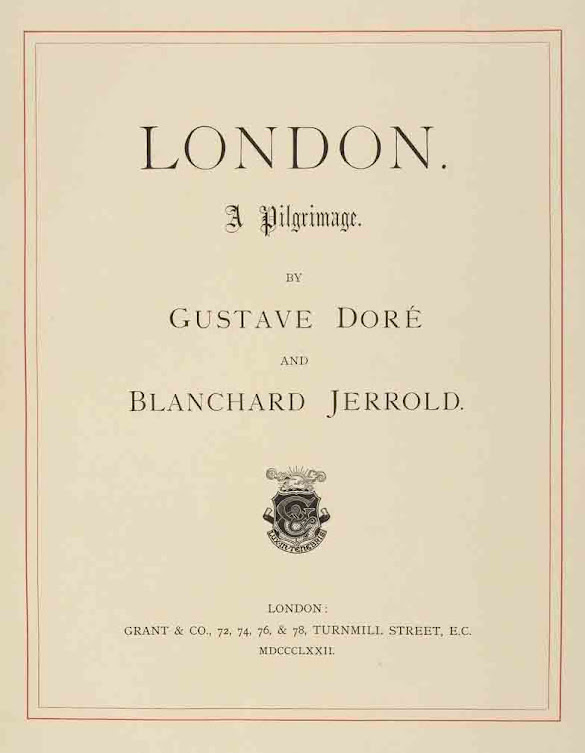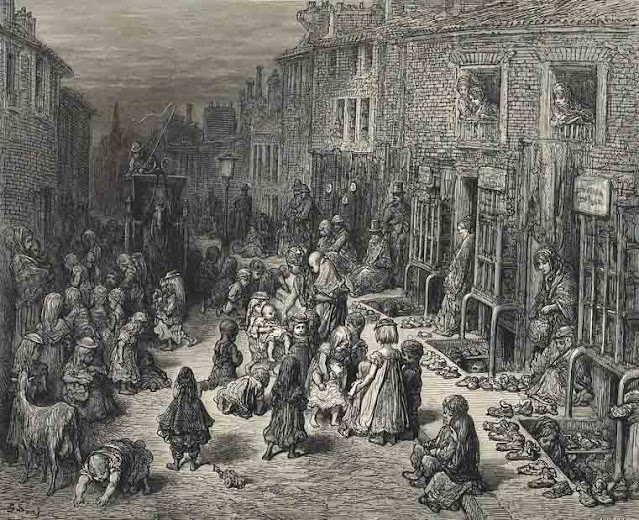Our visual image of Victorian London is largely fixated on its sordidness—cramped streets, dark alleys, desolate slums, overcrowding, and illicit dens. Two people are responsible for creating in our heads such pictures of destitution and filth—one is Charles Dickens, whose works largely revolved around grinding poverty, and the other is French illustrator Gustave Doré. Doré (1832 – 1883) was a prolific engraver, artist, illustrator, and sculptor, who became very popular both in France and England by being an extremely successful illustrator for books and magazine.
He began his career early—at the age of fifteen—working for the French paper Le journal pour rire. Before he was twenty-five, his illustrations had adorned the books of several prominent writers of his time such as Cervantes, Rabelais, Balzac, Milton, Byron, and Dante. His illustrations of Cervantes's Don Quixote left such an indelible impression on the collective imagination of the public that it forever changed how subsequent artists, stage and film directors would represent the various characters in the book in their medium. Doré's illustrations for the English Bible in 1866 was such great success that it earned him a major exhibition of his work in London, eventually leading to the foundation of his very own Dore Gallery.
In 1869, Dore teamed up with journalist Blanchard Jerrold to produce a comprehensive portrait of London. For the next four years, Jerrold and Dore explored the dark underbelly of the largest, most fashionable, and most prosperous city in the world, visiting night refuges, staying in cheap lodging houses and making rounds of the opium den. The duo were often accompanied by plain-clothes policemen. They travelled up and down the river and attended fashionable events at Lambeth Palace, the boat race and the Derby.
This is part 17 of a 25-part series on later works of Gustave Doré:
1872 London. A Pilgrimage by Gustave Doré and Blanchard Jerrold:
 |
| Front Cover |
 |
| Title Page |
 |
| Frontispiece |
 |
| Preface |
 |
| The Thames |
 |
| Hay-Boats on the Thames |
 |
| A River Side Street |
 |
| A City Thoroughfare |
 |
| Inside the Docks |
 |
| St. Katherine's Dock |
 |
| The Docks - Night Scene |
 |
Lambeth Gasworks
|
 |
| The River Bank - Under the Trees |
 |
| The Race |
 |
| Putney Bridge - The Return |
 |
| A Sale at Tatersall's |
 |
| The Derby - At Lunch |
 |
| The Derby - Tattenham Corner |
 |
| The Derby - Finish of the Race |
 |
| The Derby - Returning Home |
 |
| A Chiswick Fête |
 |
| The Stalls. Covent Garden Opera |
 |
| The Ladies' Mile |
 |
| Holland House - A Garden Party |
 |
| Westminster Abbey - Confirmation of Westminster Boys |
 |
| Westminster Abbey - The Choir |
 |
| Under the Trees - Regent's Park |
 |
| Afternoon in the Park |
 |
| The Great Tree - Kensington Gardens |
 |
| Under Green Leaves |
 |
| Zoological Gardens - The Parrot Walk |
 |
| Warehousing in the City |
 |
| Bishopsgate Street |
 |
| Ludgate Hill |
 |
| Over London - By rail |
 |
| Coffee Stall - early Morning |
 |
| Wentworth Street, Whitechapel |
 |
| Houndsditch |
 |
| 38 Brewer's Men |
 |
| Newgate - Exercise Yard |
 |
| Bluegate Fields |
 |
| Scripture Reader in a Night Refuge |
 |
| The Bull's Eye |
 |
| Opium Smoking - The Lascar's Room in "Edwin Drood" |
 |
| Turn Him Out, Ratcliff |
 |
| Billingsgate - Early Morning |
 |
| Billingsgate - Landing the Fish |
 |
| Covent Garden Market - Early Morning |
 |
| Off Billingsgate |
 |
| Dudley Street - Seven Dials |
 |
| Hampstead Heath |
 |
| Lord's |
 |
| A Ball at the Mansion House |
 |
| The Organ in the Court |
 |
| Refuge - Applying for Admission |
 |
| Found in the Street |
 |
| The New Zealander |
 |
| Railway Station |

























































